您好!
欢迎来到京东云开发者社区
登录
首页
博文
课程
大赛
工具
用户中心
开源
首页
博文
课程
大赛
工具
开源
更多
用户中心
开发者社区
>
博文
>
Intellij IDEA 插件开发
分享
打开微信扫码分享
点击前往QQ分享
点击前往微博分享
点击复制链接
Intellij IDEA 插件开发
马仁喜122815
2023-06-20
IP归属:北京
1813浏览
<span style='color:red;background:#fff;font-size:18px;'> 如有疏漏欢迎指正,如想深入了解欢迎联系探讨 写在前面:很多idea插件文档更多的是介绍如何创建一个简单的idea插件 文章的意义:开发环境、demo、生态组件、添加依赖包、源码解读、网络请求、渲染数据、页面交互等介绍,是一篇能够满足基本的插件开发工程要求的文章。 </span> ## 一、简介 <span class="md-expand" style="box-sizing: border-box;">IntelliJ IDEA 与 IntelliJ Platform</span> <span class="" style="box-sizing: border-box;">IntelliJ IDEA 简称 IDEA,是 Jetbrains 公司旗下的一款 JAVA 开发工具,支持 Java、Scala、Groovy 等语言的开发,同时具备支持目前主流的技术和框架,擅长于企业应用、移动应用和 Web 应用的开发,提供了丰富的功能,智能代码助手、代码自动提示、重构、J2EE支持、各类版本工具(git、svn等)、JUnit、CVS整合、代码分析、 创新的GUI设计等。</span> <span style="box-sizing: border-box;">IntelliJ Platform 是一个构建 IDE 的开源平台,基于它构建的 IDE 有 IntelliJ IDEA、WebStorm、DataGrip、以及 Android Studio 等等。IDEA 插件也是基于 IntelliJ Platform 开发的。</span> ## 二、开发环境搭建 注意各软件版本要对应 ### 1、开发工具 IDEA 2020.1 各版本下载地址:https://www.jetbrains.com/idea/download/other.html gradle 6.1 各版本下载地址:https://gradle.org/releases/ org.jetbrains.intellij 0.4.22 jdk 1.8 首先看一下目前idea版本的变动,找到自己当前idea对应的版本需要的jdk版本 https://plugins.jetbrains.com/docs/intellij/build-number-ranges.html?from=jetbrains.org#intellij-platform-based-products-of-recent-ide-versions 接下来需要找idea对应版本的gradle版本 https://www.jetbrains.com/legal/third-party-software/?product=iic&version=2020.1.1 最后就是找 gradle版本对应的 org.jetbrains.intellij 插件版本,在gradle-intellij-plugin插件的releases页面,这里会在描述中指出有各个插件版本对应最低的gradle版本。 https://github.com/JetBrains/gradle-intellij-plugin/releases?page=1 添加依赖到gradel配置文件,获取相关依赖配置 https://mvnrepository.com/artifact/org.springframework/spring-web ### 2、启用Plugin DevKit Plugin DevKit 是 IntelliJ 的一个插件,它使用 IntelliJ IDEA 自己的构建系统来为开发 IDEA 插件提供支持。开发 IDEA 插件之前需要安装并启用 Plugin DevKit 。 打开 IDEA,导航到 Settings \| Plugins,若插件列表中没有 Plugin DevKit,点击 Install JetBrains plugin,搜索并安装。  ### 3、配置IntelliJ Platform Plugin SDK IntelliJ Platform Plugin SDK 就是开发 IntelliJ 平台插件的SDK, 是基于 JDK 之上运行的,类似于开发 Android 应用需要 Android SDK。 3\.1导航到 File \| Project Structure,选择对话框左侧栏 Platform Settings 下的 SDKs 3.2点击 + 按钮,先选择 JDK,指定 JDK 的路径;再创建 IntelliJ Platform Plugin SDK,指定 home path 为 IDEA 的安装路径,如图  创建好 IntelliJ Platform Plugin SDK 后,选择左侧栏 Project Settings 下的 Projects,在 Project SDK 下选择刚创建的 IntelliJ Platform Plugin SDK。  ### 4、设置源码路径(可选) 4\.1查看 build 号:打开 IDEA,Help \| About,查看版本号及 build 号 4.2IDEA Community 源码(https://github.com/JetBrains/intellij-community/):切换到与 build 号相同的分支,点击 Clone or download 按钮,选择 Download ZIP  4.3选择工程结构设置后选择SDKs->选中之前在第3步添加的sdk点击SourcePath后按如下1点击添加一个sourcePath,选择上面下载额源码后点击OK、点击Applay 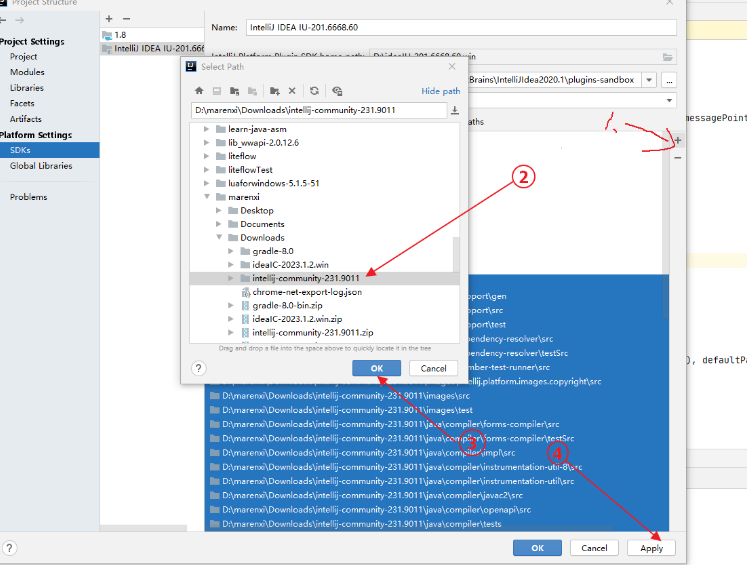 4.4未安装源码时点击某一个action(NewModuleAction)会看到如下所示阅读起来会比较晦涩难懂。  ### 5、Sandbox IntelliJ IDEA 插件以 Debug/Run 模式运行时是在 SandBox 中进行的,不会影响当前的 IntelliJ IDEA;但是同一台机器同时开发多个插件时默认使用的同一个 sandbox,即在创建 IntelliJ Platform SDK 时默认指定的 Sandbox Home  如果需要每个插件的开发环境是相互独立的,可以创建多个 IntelliJ Platform SDK,为 Sandbox Home 指定不同的目录 。 ## 三、开发一个简单插件 插件的创建、配置、运行、打包流程,以及 action ### 1、创建一个插件工程 选择 File \| New \| Project,左侧栏中选择 IntelliJ Platform Plugin 工程类型  点击 Next,设置工程名称及位置,点击 Finish 完成创建。可以到 File \| Project Structure 来自定义工程设置。 除了在idea创建插件项目外,我们还可以下载github模板代码进行修改: https://github.com/JetBrains/intellij-platform-plugin-template ### 2、插件工程结构 插件工程内容: ``` PluginDemo/ resources/ META-INF/ plugin.xml src/ com/foo/... ... ... ``` * src 实现插件功能的classes * resources/META-INF/plugin.xml 插件的配置文件,指定插件名称、描述、版本号、支持的 IntelliJ IDEA 版本、插件的 components 和 actions 以及软件商等信息。 ### 3、plugin.xml 下面示例描述了可在 plugin.xml 文件配置的主要元素: ```xml <idea-plugin> <!-- 插件名称,别人在官方插件库搜索你的插件时使用的名称 --> <name>MyPlugin</name> <!-- 插件唯一id,不能和其他插件项目重复,所以推荐使用com.xxx.xxx的格式 插件不同版本之间不能更改,若没有指定,则与插件名称相同 --> <id>com.example.plugin.myplugin</id> <!-- 插件的描述 --> <description>my plugin description</description> <!-- 插件版本变更信息,支持HTML标签; 将展示在 settings | Plugins 对话框和插件仓库的Web页面 --> <change-notes>Initial release of the plugin.</change-notes> <!-- 插件版本 --> <version>1.0</version> <!-- 供应商主页和email--> <vendor url="http://www.jetbrains.com" email="support@jetbrains.com" /> <!-- 插件所依赖的其他插件的id --> <depends>MyFirstPlugin</depends> <!-- 插件兼容IDEA的最大和最小 build 号,两个属性可以任选一个或者同时使用 官网详细介绍:http://www.jetbrains.org/intellij/sdk/docs/basics/getting_started/build_number_ranges.html--> <idea-version since-build="3000" until-build="3999"/> <!-- application components --> <application-components> <component> <!-- 组件接口 --> <interface-class>com.plugin.demo.Component1Interface</interface-class> <!-- 组件的实现类 --> <implementation-class>com.plugin.demo.impl.Component1Impl</implementation-class> </component> </application-components> <!-- project components --> <project-components> <component> <!-- 接口和实现类相同 --> <interface-class>com.plugin.demo.impl.Component2</interface-class> </component> </project-components> <!-- module components --> <module-components> <component> <interface-class>com.plugin.demo.impl.Component3</interface-class> </component> </module-components> <!-- Actions --> <actions> ... </actions> <!-- 插件定义的扩展点,以供其他插件扩展该插件 --> <extensionPoints> ... </extensionPoints> <!-- 声明该插件对IDEA core或其他插件的扩展 --> <extensions xmlns="com.intellij"> ... </extensions> </idea-plugin> ``` ### 4、创建 Action Action是实现插件功能的类, 一个Action类需要继承AnAction并且实现actionPerformed方法。当用户点击菜单或者工具栏按钮, 按快捷键,或者通过Help \| Find Action点击时, IntelliJ Platform系统会回调对应Action的actionPerformed方法。 一个 Action 表示 IDEA 菜单里的一个 menu item 或工具栏上的一个按钮,通过继承 AnAction class 实现,当选择一个 menu item 或点击工具栏上的按钮时,就会调用 AnAction 类的 actionPerformed 方法。 实现自定义 Action 分两步: * 定义一个或多个 action * 注册 action,将 item 添加到菜单或工具栏上 #### 4.1、定义 Action 定义一个 Java class,继承 AnAction 类,并重写 actionPerformed 方法, 如 ```java public class ActionDemo extends AnAction { public void actionPerformed(AnActionEvent event) { Project project = event.getData(PlatformDataKeys.PROJECT); Messages.showInputDialog( project, "What is your name?", "Input your name", Messages.getQuestionIcon()); } } ``` #### 4.2、注册 Action 在 plugin.xml 文件的` <actions>`元素内注册 ```xml <actions> <group id="MyPlugin.SampleMenu" text="Sample Menu" description="Sample menu"> <add-to-group group-id="MainMenu" anchor="last" /> <action id="Myplugin.ActionDemo" class="Mypackage.ActionDemo" text="Text Boxes" description="A test menu item" /> </group> </actions> ``` * <span style="color: rgb(51, 51, 51); font-family: Consolas, Liberation Mono, Courier, monospace; font-size: 14.4px; font-style: normal; font-variant-ligatures: normal; font-variant-caps: normal; font-weight: normal; letter-spacing: normal; orphans: 2; text-align: left; text-indent: 0px; text-transform: none; white-space: pre-wrap; widows: 2; word-spacing: 0px; -webkit-text-stroke-width: 0px; background-color: rgb(248, 248, 248); text-decoration-style: initial; text-decoration-color: initial; display: inline !important; float: none;">\<action></span>元素会定义一个 action,指定 action 的 id、实现类、显示文本、描述 * <span style="color: rgb(51, 51, 51); font-family: Consolas, Liberation Mono, Courier, monospace; font-size: 14.4px; font-style: normal; font-variant-ligatures: normal; font-variant-caps: normal; font-weight: normal; letter-spacing: normal; orphans: 2; text-align: left; text-indent: 0px; text-transform: none; white-space: pre-wrap; widows: 2; word-spacing: 0px; -webkit-text-stroke-width: 0px; background-color: rgb(248, 248, 248); text-decoration-style: initial; text-decoration-color: initial; display: inline !important; float: none;">\<group></span>元素会定义一个 action group(多个action),设置 action group 的 id、文本、描述 * <span style="color: rgb(51, 51, 51); font-family: Consolas, Liberation Mono, Courier, monospace; font-size: 14.4px; font-style: normal; font-variant-ligatures: normal; font-variant-caps: normal; font-weight: normal; letter-spacing: normal; orphans: 2; text-align: left; text-indent: 0px; text-transform: none; white-space: pre-wrap; widows: 2; word-spacing: 0px; -webkit-text-stroke-width: 0px; background-color: rgb(248, 248, 248); text-decoration-style: initial; text-decoration-color: initial; display: inline !important; float: none;">\<add-to-group></span>元素指定其外部 action 或 action group 被添加到的位置 上面示例会定义一个被添加到 IDEA 主菜单的最后面的 “SampleMenu” 的菜单,点击该菜单将弹出一个 “Text Boxes” item,如图  #### 4.3、快速创建 Action IntelliJ Platform 提供了 New Action 向导,它会帮助我们创建 action class 并配置 plugin.xml 文件: 在目标 package 上右键,选择 New \| Plugin DevKit \| Action:  * Action ID: action 唯一 id,推荐 format: PluginName.ID * Class Name: 要被创建的 action class 名称 * Name: menu item 的文本 * Description: action 描述,toolbar 上按钮的提示文本,可选 * Add to Group:选择新 action 要被添加到的 action group(Groups, Actions)以及相对其他 actions 的位置(Anchor) * Keyboard Shortcuts:指定 action 的第一和第二快捷键  注意:该向导只能向主菜单中已存在的 action group 或工具栏上添加 action,若要创建新的 action group,请参考前面的内容。 ### 5、运行调试插件 运行/调试插件可直接在 IntelliJ IDEA 进行,选择 Run \| Edit Configurations\.\.\.,若左侧栏没有 Plugin 类型的 Configuration\, 点击右上角 \+ 按钮,选择 Plugin 类型\, 如图 Use classpath of module 选择要调试的 module,其余配置一般默认即可;切换到 Logs 选项卡,如果勾选了 idea.log,运行插件时 idea.log 文件的内容将输出到 idea.log console。 运行插件点击工具栏上运行按钮Run   ### 6、打包安装插件 #### 6.1、打包插件 选择 Build \| Prepare Plugin Module ‘module name’ for Deployment 来打包插件:  jar类型的插件包: ``` PluginDemo.jar/ com/xxx/... ... ... META-INF/ plugin.xml ``` zip类型的插件包: ``` PluginDemo.zip/ lib/ libxxx.jar libbar.jar PluginDemo.jar/ com/xxx/... ... ... META-INF/ plugin.xml ``` #### 6.2、安装插件 导航到 File \| Settings \| Plugins 页面,点击 Install plugin from disk\.\.\.  * 选择插件包的位置,点击 OK * 在插件列表中,勾选插件名字后面的 check-box 来启用插件,点击 OK * 重启 IDEA Install JetBrains plugin... 从 JetBrains 仓库(https://plugins.jetbrains.com/)中安装插件 Browse repositories... 添加并管理自己的仓库 ## 四、Action允许添加的位置 这个时候我们了解的都比较浅显还停留在demo层面,如何进行深入的了解呢? eg:我们怎么知道都有哪些 action 或 action group 可以被我们添加呢? ### 1.添加主菜单MainMenu 1、我们可以点击配置group-id="MainMenu"下的MainMenu ```xml <actions> <group id="MyPlugin.SampleMenu" text="Sample Menu" description="Sample menu"> <add-to-group group-id="MainMenu" anchor="last" /> <action id="Myplugin.Textboxes" class="Mypackage.TextBoxes" text="Text Boxes" description="A test menu item" /> </group> </actions> ``` 2、进入PlatformActions.xml如下图,这个时候不难看出这里就是主菜单的第一列子菜单  3.这个时候如果我们想新建个类似与File-->New和Open的菜单该怎么做呢? 3.1我们应该先实现布局,添加主菜单MainMenu ```xml <!-- Actions --> <actions> <group id="MainMenuActionGroup" text="MainMenuActionGroup" description="MainMenuActionGroup" popup="true"> <add-to-group group-id="MainMenu" anchor="after" relative-to-action="HelpMenu"/> <action id="OpenFile" class="com.plugin.demo.action.MainMenuOpenFileAction" text="Open" description="主菜单File下的Open子菜单"/> <separator/> </group> <group id="JavaNewProjectOrModuleGroup" text="一级菜单" popup="true"> <add-to-group group-id="MainMenuActionGroup" anchor="before" relative-to-action="OpenFile"/> <action id="NewProject" class="com.intellij.ide.actions.NewProjectAction"/> <action id="ImportProject" class="com.intellij.ide.actions.ImportProjectAction"/> <action id="ProjectFromVersionControl" class="com.intellij.openapi.wm.impl.welcomeScreen.ProjectFromVersionControlAction"/> <separator/> <action id="NewModule" class="com.intellij.openapi.roots.ui.configuration.actions.NewModuleAction"/> <action id="ImportModule" class="com.intellij.ide.actions.ImportModuleAction"/> </group> </actions> ``` 3.2实现自定义的打开文件 其实是通过下面的action配置的OpenFileAction找到源码 ```xml <action id="OpenFile" class="com.intellij.ide.actions.OpenFileAction" icon="AllIcons.Actions.Menu_open"/> ``` 在将源码拷贝出来粘贴到自己的action内。这样就可以实现自己的主菜单File下的Open子菜单 3.3这个时候有人会有疑问我不知道去哪找New对应的action呀? 这个时候我们通过界面可以看到Project from Existing Sources...,这里我们就可以去搜这个文本呀。既然显示在页面上。必然有地方定义了它。 ActionBundle.properties  这个时候我们在根据对应的action定义的文本在去搜索对应的action,com.intellij.ide.actions.ImportProjectAction  3.4这个时候我们将对应的action拷贝到自己的插件定义的配置上也就形成了3.1的一级和二级菜单  ### 2.添加主工具栏MainToolBar 添加主工具栏MainToolBar(如果不清楚哪里是主菜单、主工具栏、导航栏、上下文菜单、弹出菜单参考https://www.w3cschool.cn/intellij\_idea\_doc/intellij\_idea\_doc-34852d55.html) ```xml <group> <add-to-group group-id="MainToolBar" anchor="before" relative-to-action="SearchEverywhere"/> <reference ref="MainMenuActionGroup"></reference> </group> ```  ### 3、添加上下文菜单ProjectViewPopupMenu ```xml <group> <add-to-group group-id="ProjectViewPopupMenu" anchor="before" relative-to-action="WeighingNewGroup"/> <reference ref="MainMenuActionGroup"></reference> </group> ```  ### 4、添加弹出菜单EditorPopupMenu ```xml <!--添加到弹出框右键--> <group> <add-to-group group-id="EditorPopupMenu" anchor="before" relative-to-action="ShowIntentionsGroup"/> <reference ref="MainMenuActionGroup"></reference> </group> ```  ### 5、添加打印ConsoleEditorPopupMenu ```xml <!--添加到控制台打印右键--> <group> <add-to-group group-id="ConsoleEditorPopupMenu" anchor="before" relative-to-action="CutCopyPasteGroup"/> <reference ref="MainMenuActionGroup"></reference> </group> ```  ### 6、右键新建action时也可以直接选择添加的位置。 1.筛选后查找要添加的group 2.选择对应的action 3.选择要添加到这个action的某个位置  ## 五、Components(已不建议使用) IntelliJ IDEA 的组件模型是基于 PicoContainer 的,组件都包含在这些容器中,但容器有三种级别:application container,project container 以及 module container。application container 可以包含多个 project container,而 project container 可以包含多个 module container。 ### 1、Components 类型 Components 是插件开发的基础,Components 有三种类型:  ### 2、注册 Components components 需要配置在 plugin.xml 中,并指定 interface 和 implementation,interface 类用于从其他组件中检索组件,implementation 类用于实例化组件。示例: ```java //创建一个 application level component public interface Component1 extends ApplicationComponent { } public class Component1Impl implements Component1 { @Override public String getComponentName() { return "PluginDemo.Component1"; } } ``` plugin.xml ```xml <application-components> <component> <interface-class>com.example.test.Component1</interface-class> <implementation-class>com.example.test.Component1Impl</implementation-class> </component> </application-components> ``` <span style="color:red;background:#fff;font-size:18px;">注意:一个 interface-class 不能有多个 implementation-class,如下图:</span>  1. 若组件没有创建 interface 类,而是直接实现了 ApplicationComponent 等接口,interface 和 implementation 可以指定为同一个类。 2. 每一个组件都应该有一个唯一的名字,通过 getComponentName() 返回,推荐使用 <plugin\_name>.<component\_name> 格式。 ### 3、Component 周期方法 ApplicationComponent 的生命周期方法: ```java //构造方法 public constructor(){ } //初始化 public void initComponent() { } public void disposeComponent() { } ``` ProjectComponent 的生命周期方法: ```java //构造方法 public constructor(){ } //通知一个project已经完成加载 public void projectOpened() { } public void projectClosed() { } //执行初始化操作以及与其他 components 的通信 public void initComponent() { } //释放系统资源或执行其他清理 public void disposeComponent() { } ``` ModuleComponent 的生命周期方法: ModuleComponent 的生命周期方法中比 ProjectComponent 多一个 moduleAdded(),用于通知 module 已经被添加到 project 中。 ### 4、Component 加载 Application 级别的 components 在 IDEA 启动时加载,Project 和 Module 级别的 components 在项目启动时共同加载。 一个组件加载过程: 1. 创建:调用构造方法 2. 初始化:调用 initComponent() 方法 3. 如果是 Project 组件,会调用 projectOpened() 方法; 如果是 Module 组件,会依次调用 moduleAdded() 和 projectOpened() 方法 如果 component 在加载时需要用到其他 component,我们只需在该 component 的构造方法的参数列表声明即可,在这种情况下,IntelliJ IDEA 会按正确的顺序实例化所依赖的 component。 示例: ```java public class MyComponent implements ApplicationComponent { private final MyOtherComponent otherComponent; public MyComponent(MyOtherComponent otherComponent) { this.otherComponent = otherComponent; } ... } ``` ### 5、Component 卸载 一个组件卸载过程: 1. 如果是 Project 或 Module 组件,调用 projectClosed() 2. 接下来 disposeComponent() 将被调用 ### 6、Component 容器 前面我们提到有三种不同的容器,application container 实现 Application 接口; project container 实现 Project 接口; module container 实现 Module 接口。每一个容器都有自己的方法去获取容器内的 component。 获取 application 容器及其内部的组件: ```java /获取application容器 Application application = ApplicationManager.getApplication(); //获取application容器中的组件 MyComponent myComponent = application.getComponent(MyComponent.class); ``` 获取 project / module 容器及其内部的组件: 在 component 构造方法的参数列表中声明: ```java public class MyComponent implements ProjectComponent { Project project; public MyComponent(Project project){ this.project = project; } public void initComponent() { OtherComponent otherComponent = project.getComponent(OtherComponent.class); } } ``` 在这个例子中,组件在构造方法中获取了容器对象,将其保存,然后在 component 其他地方进行引用。 ### 7、 各组件使用时机 7.1创建一个ApplicationComponent ```java package com.plugin.demo.component; import com.intellij.openapi.components.ApplicationComponent; //创建一个 application level component public interface ApplicationComponentDemo extends ApplicationComponent { } package com.plugin.demo.component; import com.intellij.openapi.application.Application; import com.intellij.openapi.application.ApplicationManager; public class ApplicationComponentDemoImpl implements ApplicationComponentDemo { @Override public String getComponentName() { System.out.println("ApplicationComponentDemoImpl = " +this.getClass().getName()); return this.getClass().getName(); } //初始化 public void initComponent() { System.out.println("ApplicationComponentDemoImpl initComponent" ); } public void disposeComponent() { //获取application容器 Application application = ApplicationManager.getApplication(); //获取application容器中的组件 ApplicationComponentDemoImpl myComponent = application.getComponent(ApplicationComponentDemoImpl.class); System.out.println("disposeComponent = " + myComponent.getComponentName()); } } ``` 7.2创建一个ProjectComponent ```java package com.plugin.demo.component; import com.intellij.openapi.application.Application; import com.intellij.openapi.application.ApplicationManager; import com.intellij.openapi.components.ProjectComponent; import org.jetbrains.annotations.NotNull; public class ProjectComponentDemo implements ProjectComponent { @NotNull @Override public String getComponentName() { //获取application容器 Application application = ApplicationManager.getApplication(); //获取application容器中的组件 ApplicationComponentDemoImpl myComponent = application.getComponent(ApplicationComponentDemoImpl.class); System.out.println("ProjectComponentDemo = " + myComponent.getComponentName()); return myComponent.getComponentName(); } @Override public void initComponent() { // 获取application容器 Application application = ApplicationManager.getApplication(); // 获取application容器中的组件 ApplicationComponentDemo component = application.getComponent(ApplicationComponentDemo.class); System.out.println("ApplicationComponentDemoImpl initComponent = " + component.getComponentName()); System.out.println("ProjectComponentDemo initComponent"); } @Override public void disposeComponent() { //获取application容器 Application application = ApplicationManager.getApplication(); //获取application容器中的组件 ApplicationComponentDemoImpl myComponent = application.getComponent(ApplicationComponentDemoImpl.class); System.out.println("disposeComponent = " + myComponent.getComponentName()); } } ``` 7.3创建一个ModuleComponent ```java package com.plugin.demo.component; import com.intellij.openapi.application.Application; import com.intellij.openapi.application.ApplicationManager; import com.intellij.openapi.components.ApplicationComponent; import com.intellij.openapi.module.ModuleComponent; import com.intellij.openapi.project.Project; import com.intellij.openapi.project.ProjectManager; import org.jetbrains.annotations.NotNull; public class ModuleComponentDemo implements ModuleComponent { @NotNull @Override public String getComponentName() { //获取application容器 Application application = ApplicationManager.getApplication(); //获取application容器中的组件 ApplicationComponentDemoImpl myComponent = application.getComponent(ApplicationComponentDemoImpl.class); System.out.println("ApplicationComponentDemoImpl initComponent = " + myComponent.getComponentName()); ProjectManager projectManager = ProjectManager.getInstance(); Project defaultProject = projectManager.getDefaultProject(); ProjectComponentDemo component = defaultProject.getComponent(ProjectComponentDemo.class); System.out.println("ProjectComponentDemo initComponent" + component.getComponentName()); return myComponent.getComponentName(); } @Override public void initComponent() { System.out.println("ModuleComponentDemo initComponent"); } @Override public void disposeComponent() { //获取application容器 Application application = ApplicationManager.getApplication(); //获取application容器中的组件 ApplicationComponentDemoImpl myComponent = application.getComponent(ApplicationComponentDemoImpl.class); System.out.println("disposeComponent = " + myComponent.getComponentName()); } } ``` 7.4注册配置Component ```xml <application-components> <component> <interface-class>com.plugin.demo.component.ApplicationComponentDemo</interface-class> <implementation-class>com.plugin.demo.component.ApplicationComponentDemoImpl</implementation-class> </component> </application-components> <project-components> <component> <interface-class>com.plugin.demo.component.ProjectComponentDemo</interface-class> <implementation-class>com.plugin.demo.component.ProjectComponentDemo</implementation-class> </component> </project-components> <module-components> <component> <interface-class>com.plugin.demo.component.ModuleComponentDemo</interface-class> <implementation-class>com.plugin.demo.component.ModuleComponentDemo</implementation-class> </component> </module-components> ``` 7.5运行后的预期是先执行应用层组件,在执行工程级组件,在执行模块级组件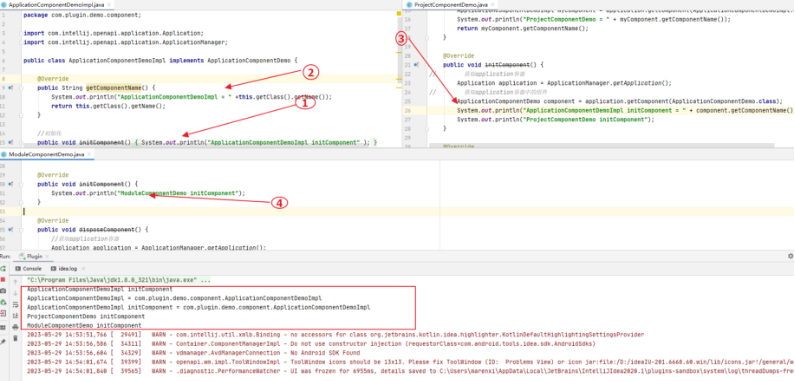 ## 六、Extensions and Extension Points 如果插件需要扩展 IDEA Platform 或 其他插件的功能,或为其他插件提供可以扩展自己的接口,那么就要用到 extensions 和 extension points,用于与 IDEA 和其他插件交互。 ### 1、Extension points 扩展点 extension point 用于数据信息扩展,使其他插件可以扩展本插件的功能,可通过plugin.xml 的 元素声明,如下示例: ```xml <extensionPoints> <!--使用beanClass声明--> <extensionPoint name="MyExtensionPoint1" beanClass="MyPackage.MyBeanClass" area="IDEA_APPLICATION"> <with attribute="implementationClass" implements="MyPackage.MyAbstractClass"/> </extensionPoint> <!--使用interface声明--> <extensionPoint name="MyExtensionPoint2" interface="MyPlugin.MyInterface" area="IDEA_PROJECT" /> </extensionPoints> ``` * name 指定 extension point 的名字,当其他插件扩展该extensionPoint时,需要指定该name * area 有三种值,IDEAAPPLICATION,IDEAPROJECT,IDEA\_MODULE,指定extension point的级别 * interface 指定需要扩展此 extension point 的插件必须要实现的接口 * beanClass 指定一个类,该类有一个或多个被 @Attribute 注解的属性 * 声明 extension point 有两种方式,指定 beanClass 或 interface * 如果某个属性需要是某个类的子类,或某个接口的实现类,需要通过 指明类名或接口名。 示例上述代码中的 MyExtensionPoint1 的 beanClass: ```java public class MyBeanClass extends AbstractExtensionPointBean { @Attribute("key") public String key; @Attribute("implementationClass") public String implementationClass; ... } ``` ### 2、Extension 扩展其他插件功能 如果插件需要扩展 IntelliJ Platform 或其他插件的功能,需要声明一个或多个 extension。 1. 设置 的 defaultExtensionNs 属性若是扩展 IntelliJ Platform,设为 com.intellij若是扩展其他插件,则设为 pluginId 2. 指定要扩展哪个 extension point内部的子标签的名字必须与 extension point 的 name 属性相同 3. 如果 extension point * 是通过 interface 声明的,那么使用 implementation 属性指明 interface 的实现类 * 是通过 beanClass 声明的,那么就要为 beanClass 中被 @Attribute 注解的属性指定属性值 示例: ```xml <!-- 扩展 interface 声明的 extensionPoint --> <extensions defaultExtensionNs="com.intellij"> <appStarter implementation="MyPackage.MyExtension1" /> <applicationConfigurable implementation="MyPackage.MyExtension2" /> </extensions> <!-- 扩展 beanClass 声明的 extensionPoint --> <extensions defaultExtensionNs="pluginId"> <MyExtensionPoint1 key="keyValue" implementationClass="MyPackage.MyClassImpl"></MyExtensionPoint1> </extensions> ``` 插件的 service 的实现就是扩展 IDEA Platform 的 applicationService 或 projectService 两个 extension points ### 3、获取 extension points IntelliJ Platform 的部分 extension points ```xml <extensionPoints> <extensionPoint name="languageBundle" beanClass="com.intellij.DynamicBundle$LanguageBundleEP"/> <!--suppress PluginXmlValidity --> <extensionPoint name="applicationService" beanClass="com.intellij.openapi.components.ServiceDescriptor" dynamic="true"/> <!--suppress PluginXmlValidity --> <extensionPoint name="projectService" beanClass="com.intellij.openapi.components.ServiceDescriptor" dynamic="true"/> <!--suppress PluginXmlValidity --> <extensionPoint name="moduleService" beanClass="com.intellij.openapi.components.ServiceDescriptor" dynamic="true"/> <extensionPoint name="virtualFileManagerListener" interface="com.intellij.openapi.vfs.VirtualFileManagerListener" dynamic="true"/> <extensionPoint name="vfs.asyncListener" interface="com.intellij.openapi.vfs.AsyncFileListener" dynamic="true"/> <!-- only bundled plugin can define startupActivity --> <extensionPoint name="startupActivity" interface="com.intellij.openapi.startup.StartupActivity"/> <extensionPoint name="postStartupActivity" interface="com.intellij.openapi.startup.StartupActivity" dynamic="true"/> <extensionPoint name="backgroundPostStartupActivity" interface="com.intellij.openapi.startup.StartupActivity" dynamic="true"/> <extensionPoint name="fileTypeDetector" interface="com.intellij.openapi.fileTypes.FileTypeRegistry$FileTypeDetector" dynamic="true"/> <extensionPoint name="editorFactoryDocumentListener" interface="com.intellij.openapi.editor.event.DocumentListener" dynamic="true"/> <extensionPoint name="multiHostInjector" interface="com.intellij.lang.injection.MultiHostInjector" area="IDEA_PROJECT" dynamic="true"/> <extensionPoint name="writingAccessProvider" area="IDEA_PROJECT" interface="com.intellij.openapi.vfs.WritingAccessProvider" dynamic="true"/> <extensionPoint name="metaLanguage" interface="com.intellij.lang.MetaLanguage"/> <extensionPoint name="lang.parserDefinition" beanClass="com.intellij.lang.LanguageExtensionPoint" dynamic="true"> <with attribute="implementationClass" implements="com.intellij.lang.ParserDefinition"/> </extensionPoint> <extensionPoint name="lang.elementManipulator" beanClass="com.intellij.openapi.util.ClassExtensionPoint" dynamic="true"> <with attribute="implementationClass" implements="com.intellij.psi.ElementManipulator"/> </extensionPoint> <!--suppress PluginXmlValidity --> <extensionPoint name="stubElementTypeHolder" beanClass="com.intellij.psi.stubs.StubElementTypeHolderEP" dynamic="true"/> </extensionPoints> <extensions defaultExtensionNs="com.intellij"> <applicationService serviceInterface="com.intellij.util.messages.MessageBusFactory" serviceImplementation="com.intellij.util.messages.impl.MessageBusFactoryImpl"/> </extensions> ``` 其他可以从被扩展插件的 plugin.xml 文件中获取 https://plugins.jetbrains.com/intellij-platform-explorer/extensions ## 七、Service 参考:https://plugins.jetbrains.com/docs/intellij/plugin-services.html#examples Service 也是一种按需加载的 component,在调用 ServiceManager.getService(Class)时才会加载,且程序中只有一个实例。 Service是插件的一个组件, 是为了把公共的逻辑放到一起,Service的实例是单例的。 Serivce 在 IntelliJ IDEA 中是以 extension point 形式提供的,实现自己的 service 需要扩展相应 extension point。 * applicationService: application level service * projectService: project level service * moduleService: module level service 声明 service 时必须包含 serviceImplementation 属性用于实例化 service, serviceInterface 属性是可选的,可用于获取 service 实例。 ### 1、创建 Service 在需要放置 service 的 package 上右键, New \| Plugin DevKit \| xxxxService,如图  选择相应 service,弹出如下对话框,填写 interface 类和 implementation 类,若不勾选 Separate interface from implementation,只需填写 implementation 类。  IntelliJ IDEA 会自动创建相应类并配置 plugin.xml 文件。 示例:plugin.xml: ```xml <extensions defaultExtensionNs="com.intellij"> <applicationService serviceInterface="com.plugin.demo.service.ApplicationServiceDemo" serviceImplementation="com.plugin.demo.service.impl.ApplicationServiceDemoImpl"/> <projectService serviceInterface="com.plugin.demo.service.ProjectServiceDemo" serviceImplementation="com.plugin.demo.service.impl.ProjectServiceDemoImpl"/> <moduleService serviceInterface="com.plugin.demo.service.ModuleServiceDemo" serviceImplementation="com.plugin.demo.service.impl.ModuleServiceDemoImpl"/> </extensions> ``` 生成的 service 类: ```java public interface ApplicationServiceDemo { static ApplicationServiceDemo getInstance() { return ServiceManager.getService(ApplicationServiceDemo.class); } } public interface ProjectServiceDemo { static ProjectServiceDemo getInstance(@NotNull Project project) { return ServiceManager.getService(project, ProjectServiceDemo.class); } } public interface ModuleServiceDemo { static ModuleServiceDemo getInstance(@NotNull Module module) { return module.getService(ModuleServiceDemo.class); } } ``` ```java public class ApplicationServiceDemoImpl implements ApplicationServiceDemo { public ApplicationServiceDemoImpl() { System.out.println("ApplicationServiceDemoImpl = "); } } public class ProjectServiceDemoImpl implements ProjectServiceDemo { public ProjectServiceDemoImpl(Project project) { System.out.println("ProjectServiceDemoImpl = " + project); } } public class ModuleServiceDemoImpl implements ModuleServiceDemo { public ModuleServiceDemoImpl(Module project) { System.out.println("ModuleServiceDemoImpl = " + project); } } ``` ### 2、获取 Service ```java MyApplicationService applicationService = ServiceManager.getService(MyApplicationService.class); //获取 project 级别的 service,需要提供 project 对象 MyProjectService projectService = ServiceManager.getService(project, MyProjectService.class); //获取 module 级别的 service,需要提供 module 对象 MyModuleService moduleService = ModuleServiceManager.getService(module, MyModuleService.class); ``` ## 八、持久化状态 我们在使用 IDE 开始开发工作之前,总是要先在 settings 页面进行一些设置,且每次重新打开 IDE 后这些设置仍然保留着,那么这些设置是如何保存下来的呢? IntelliJ Platform 提供了一些 API,可以使 components 或 services 在每次打开 IDE 时仍然使用之前的数据,即持久化其状态。 ### 1、PropertiesComponent 对于一些简单少量的值,我们可以使用 PropertiesComponent,它可以保存 application 级别和 project 级别的值。 下面方法用于获取 PropertiesComponent 对象: ```java //获取 application 级别的 PropertiesComponent PropertiesComponent.getInstance() //获取 project 级别的 PropertiesComponent,指定相应的 project PropertiesComponent.getInstance(Project) propertiesComponent.setValue(name, value) propertiesComponent.getValue(name) ``` PropertiesComponent 保存的是键值对,由于所有插件使用的是同一个 namespace,强烈建议使用前缀来命名 name,比如使用 plugin id。 ### 2、PersistentStateComponent PersistentStateComponent 用于持久化比较复杂的 components 或 services,可以指定需要持久化的值、值的格式以及存储位置。 要使用 PersistentStateComponent 持久化状态: * 需要提供一个 PersistentStateComponent 接口的实现类(component 或 service),指定类型参数,重写 getState() 和 loadState() 方法 * 类型参数就是要被持久化的类,它可以是一个 bean class,也可以是 PersistentStateComponent实现类本身。 * 在 PersistentStateComponent 的实现类上,通过 @com.intellij.openapi.components.State 注解指定存储的位置 下面通过两个例子进行说明: ```java class MyService implements PersistentStateComponent<MyService.State> { //这里 state 是一个 bean class static class State { public String value; ... } //用于保存当前的状态 State myState; // 从当前对象里获取状态 public State getState() { return myState; } // 从外部加载状态,设置给当前对象的相应字段 public void loadState(State state) { myState = state; } } ``` ```java // 这里的 state 就是实现类本身 class MyService implements PersistentStateComponent<MyService> { public String stateValue; ... public MyService getState() { return this; } public void loadState(MyService state) { XmlSerializerUtil.copyBean(state, this); } } ``` #### 2.1、实现 State 类 a、字段要求 state 类中可能有多个字段,但不是所有字段都可以被持久化,可以被持久化的字段: * public 字段 * bean 属性:提供 getter 和 setter 方法 * 被注解的私有字段:使用 @Tag, @Attribute, @Property, @MapAnnotation, @AbstractCollection 等注解来自定义存储格式,一般在实现向后兼容时才考虑使用这些注解 这些字段也有类型要求: * 数字(包括基础类型,如int,和封装类型,如Integer) * 布尔值 * 字符串 * 集合 * map * 枚举 如果不希望某个字段被持久化,可以使用 @com.intellij.util.xmlb.annotations.Transient 注解。 b、构造器要求 state 类必须有一个默认构造器,这个构造器返回的 state 对象被认为是默认状态,只有当当前状态与默认状态不同时,状态才会被持久化。 #### 2.2、定义存储位置 我们可以使用 @State 注解来定义存储位置 ```java @State(name = "PersistentDemo", storages = {@Storage(value = "PluginDemo.xml")}) public class PersistentDemo implements PersistentStateComponent<PersistentDemo> { ... } ``` name: 定义 xml 文件根标签的名称 storages: 一个或多个 @Storage,定义存储的位置 * 若是 application 级别的组件运行调试时 xml 文件的位置: \~/IdeaICxxxx/system/plugins-sandbox/config/options正式环境时 xml 文件的位置: \~/IdeaICxxxx/config/options * 若是 project 级别的组件,默认为项目的 .idea/misc.xml,若指定为 StoragePathMacros.WORKSPACE\_FILE,则会被保存在 .idea/worksapce.xml #### 2.3、生命周期 * loadState() 当组件被创建或 xml 文件被外部改变(比如被版本控制系统更新)时被调用 * getState() 当 settings 被保存(比如settings窗口失去焦点,关闭IDE)时,该方法会被调用并保存状态值。如果 getState() 返回的状态与默认状态相同,那么什么都不会被保存。 * noStateLoaded() 该方法不是必须实现的,当初始化组件,但是没有状态被持久化时会被调用 #### 2.4、组件声明 持久化组件可以声明为 component,也可以声明为 service 声明为 service,plugin.xml 文件如下配置: ```xml <extensions defaultExtensionNs="com.intellij"> <applicationService serviceImplementation="com.example.test.persisting.PersistentDemo"/> <projectService serviceImplementation="com.example.test.persisting.PersistentDemo2"/> </extensions> ``` 代码中获取状态与获取 service 的方式一样: ```java PersistentDemo persistDemo = ServiceManager.getService(PersistentDemo.class); PersistentDemo2 persistDemo2 = ServiceManager.getService(project,PersistentDemo.class); ``` 声明为 component,plugin.xml 文件如下配置: ```xml <application-components> <!--将持久化组件声明为component--> <component> <implementation-class>com.example.persistentdemo.PersistentComponent</implementation-class> </component> </application-components> ``` 获取状态与获取 component 的方式一样: ```java public static PersistentComponent getInstance() { return ApplicationManager.getApplication().getComponent(PersistentComponent.class); } public static PersistentComponent getInstance(Project project) { return project.getComponent(PersistentComponent.class); } ``` ## 九、插件依赖 开发插件时可能会用到其他插件,可能是 IDEA 绑定的,也可能是第三方的插件。 配置插件依赖需要将插件包添加到 SDK 的 classpath 中,并在 plugin.xml 配置。 1. 确定插件包的位置如果插件是 IDEA 捆绑的插件,那么插件包在 IDEA 安装目录的 plugins/ 或 plugins//lib 下。如果插件是第三方或自己的,那么需要先运行一次 sandbox(其实我们在运行调试插件的时候就是在运行sandbox)并从本地或插件仓库安装依赖插件。安装好后,插件包会放在 sandbox 目录下的 config/plugins/ 或 config/plugins//lib,查看 sandbox 目录:打开 IntelliJ Platform SDK 配置页面,其中 Sandbox Home 就是其目录。 2. 将插件包添加到 SDK 的 classpath 中导航到 File \| Project Structure \| SDKs,选择插件使用的 IntelliJ Platform SDK,点击右侧 \+ 号,在弹出的文件选择框中选择要依赖的插件包,点击 OK。 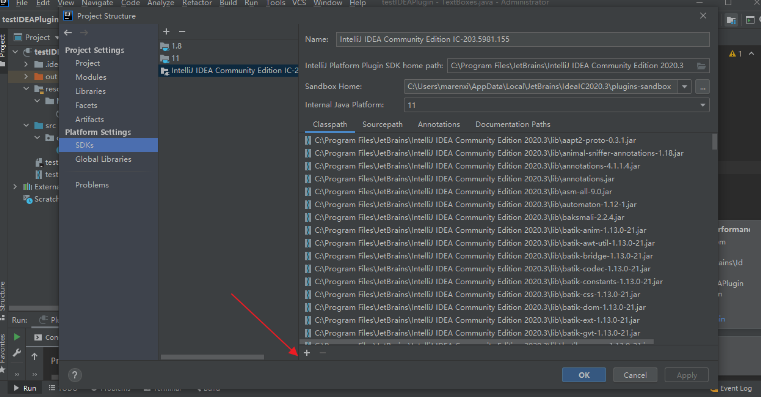 配置 plugin.xml在 plugin.xml 的 部分添加所依赖插件的id。 ``` <depends>org.jetbrains.kotlin</depends> ``` plugin id 可以从插件包的 plugin.xml 文件查看。 ## 十、GUI 介绍 GUI 是 IntelliJ IDEA 提供的一个自动生成 java 布局代码的工具,它使用 JDK 中的 Swing 控件来实现 UI 界面。 使用步骤: ### 1.配置 配置 GUI首先打开 Settings 对话框,选择 Editor \| GUI Designer,如图,在 Generate GUI into: 有两个选项,生成 class 文件或 java 代码,我们选择生成 java 代码,因为建好布局后可能需要修改代码。其他默认即可。  ### 2.创建 form 创建 form 文件form 文件用于记录界面布局。在相应的 package 上右键,选择 New \| GUI Form,如图,输入 form 文件名,一般与 java 文件名相同,点击 OK 创建 form 与 java 文件。  ### 3.面板介绍 编辑界面打开 form 文件,如图,通过拖拽控件来搭建布局。每个form文件布局的 root 控件都是一个 JPanel,可将该 root 对象传给需要该布局的类。注意:左下角的属性面板,只有当填写了 field name 属性时该控件的对象才会被当成成员变量,否则为局部变量。  ### 4.构建 生成 java 代码搭建好布局后,点击 build 编译按钮,即可生成 java 的源码文件。 GUI 生成的方法名前后都有三个 $ 标识,当再次修改布局时,GUI 只会修改 $ 标识的方法。  ## 十一、源码分析SmartConverter SmartConverter -- POJO Object Converter 项目地址:https://github.com/zitiger/smartconverter ### 1、项目背景 在分层开发中,我们总是面临着各种POJO(DTO,DO,JO,VO)对象之间的相互转换。当对象比较复杂时,编写转换代码耗时较多,且非常容易出错。以至于可能会出现写一天代码,半天在写各种convert的囧境。 为了实现自动转换,出现了BeanUtil和ModelMapper等解决方案。这些方案,在少量对象转换时,性能损耗可以忽略,但是当转换数量达到一定量级时,这种损耗会对性能产生影响。 本插件可以自动生成POJO之间的转换代码,省去手工转换的麻烦,也不会损失性能。 ### 2、安装 下载SmartConverter.zip,并在Intellij Idea中安装; ### 3、四个转换函数 1. 把光标放到函数中,不能是函数内. 2. 光标移动到函数体内,按下⌘+N,在弹出的Generate菜单中选择Smart Converter; 3. 插件自动生成一下四个转换函数 * A -> B * B -> A * List<A href=""> -> List</A> * List <B>-> List</B> ### 4、单个抓换函数 1. 在编辑器中,确定返回值和参数,完成空转换函数; ```java public static List<UserJO> toDTOList(List<UserDTO> userDTOList) { } ``` 2. 光标移动到函数体内,按下⌘+N,在弹出的Generate菜单中选择Smart Converter; 3. 插件根据入参和出参推断出需要转换的POJO。  ### 5、插件特色 插件自动从转换函数的参数和返回值推断出转换POJO; 支持List之间的转换。 如果存在单个转换的函数,则直接使用 如果不存在单个转换的函数,创建单个转换函数 支持嵌套转换 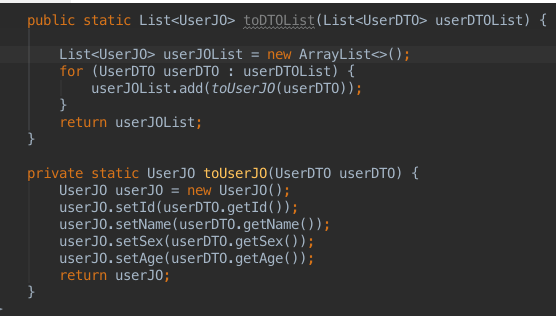 ### 6、源码解读 #### 6.1.如何将ConvertGeneratorAction 添加到菜单 因为使用SmartConvert是使用alt+insert弹出或者右键点击Generate显示SmartConvertAction,所以根据前文的添加位置不难推断添加在弹出菜单EditorPopupMenu下,这个时候我们可以从两个方向找他添加的位置。 首先从项目的配置文件进入找到plugin.xml下配置的action。由此不难看出它实际是添加在了GenerateGroup这个组上的 ```xml <actions> <group id="com.zitiger.plugin.converter.generate.group" popup="true"> <separator/> <!-- Add your actions here --> <action id="com.zitiger.plugin.converter.action.generator" class="com.zitiger.plugin.converter.action.ConvertGeneratorAction" text="Smart Converter" description="Smart Converter"> <keyboard-shortcut keymap="$default" first-keystroke="shift meta N"/> </action> <add-to-group group-id="GenerateGroup" anchor="last"/> </group> </actions> ```  这个时候我们不难看出并没有地方引用这个组,这个时候我们不防从使用的地方入手,我们是右键点击Generate或者alt+insert弹出的EditorLangPopupMenu下的Generate的组。这个时候我们去全局搜索EditorPopupMenu 发现这里有一个添加到右键菜单下的 ```xml <group id="EditorLangPopupMenu"> <separator/> <group id="EditorPopupMenu.GoTo" popup="true"> <reference ref="ShowNavBar"/> <reference ref="GotoDeclaration"/> <reference ref="GotoImplementation"/> <reference ref="GotoTypeDeclaration"/> <reference ref="GotoSuperMethod"/> <reference ref="GotoTest"/> </group> <reference ref="Generate"/> <separator/> <group id="EditorPopupMenu.Run"> <reference ref="RunContextPopupGroup"/> </group> <separator/> <reference ref="VersionControlsGroup"/> <separator/> <reference ref="ExternalToolsGroup"/> <add-to-group group-id="EditorPopupMenu" relative-to-action="CompareClipboardWithSelection" anchor="before"/> </group> ``` 点击后跳转的是 ```xml <action id="Generate" class="com.intellij.codeInsight.generation.actions.GenerateAction"/> ``` GenerateAction的点击方法actionPerformed内动态生成了ActionGroup ```java JBPopupFactory.getInstance().createActionGroupPopup(CodeInsightBundle.message("generate.list.popup.title"), wrapGroup(getGroup(),dataContext,project),dataContext,JBPopupFactory.ActionSelectionAid.SPEEDSEARCH, false); ``` 而getGroup() 通过指定groupid 获取到GenerateGroup的Action组 ```java return (DefaultActionGroup)ActionManager.getInstance().getAction(IdeActions.GROUP_GENERATE); ```  #### 6.2.如何实现实体\~\~\~\~转换 ##### 2.1Program Structure Interface (PSI) https://plugins.jetbrains.com/docs/intellij/psi-files.html 程序结构接口,通常简称为 PSI,负责解析文件并创建语法和语义代码模型,为平台的众多功能提供支持。 PSI文件是结构的根,将文件内容表示为特定编程语言中元素的层次结构 PsiFile是所有 PSI 文件的公共基类,而特定语言的文件通常由其子类表示。例如PsiJavaFile类代表一个Java文件,类XmlFile代表一个XML文件。 ##### 2.2查看某一个文件的PSI结构 参考文档:PSI Viewer https://www.jetbrains.com/help/idea/psi-viewer.html?\_ga=2.203993552.1175576577.1685324427-1690948556.1684890471&\_gl=1y6ns8zgaMTY5MDk0ODU1Ni4xNjg0ODkwNDcxga\_9J976DJZ68\*MTY4NTQxNDQzMS4xOS4xLjE2ODU0MTU2NTguMC4wLjA. 未配置开启查看PIS结构时如下图  开启查看PIS结构 找到idea安装路径下的bin目录下的idea.properties配置如下 ``` idea.is.internal=true ```  开启后显示了View PSI Structure 和View PSI Structure of Current File 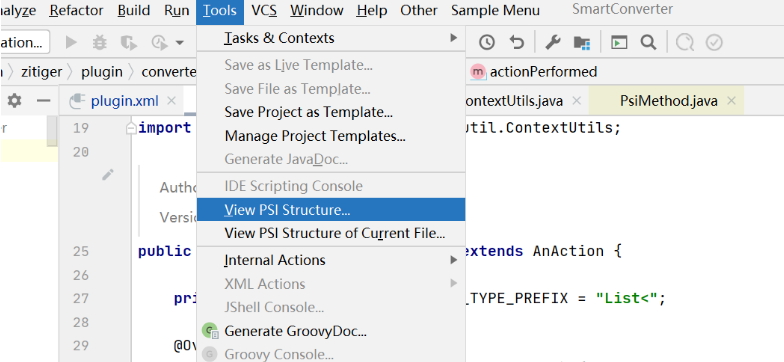 进入要查看结构的文件后点击View PSI Structure of Current File 查看某一个文件的psi结构 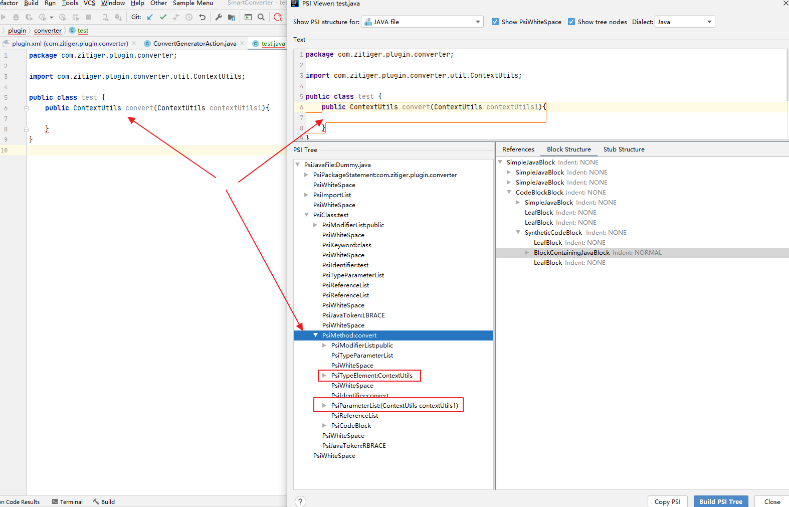 ##### 2.3查看插件源码 进入ConvertGeneratorAction的点击事件方法不难看到如下的根据PSI获取当前类和方法的代码 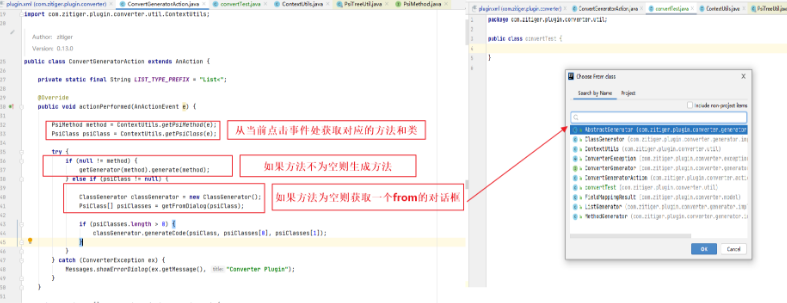 ##### 2.4继续跟踪生成方法转换代码 这里主要是根据返回类型获取到了一个MethodGenerator并执行对应的generateCode方法  ##### 2.5MethodGenerator下的generateCode MethodGenerator下的generateCode主要获取了当前方法的入参fromClass与toClass,并进行了字符串的组装和生成代码块。  PsiCodeBlock codeBlock = elementFactory. createCodeBlockFromText("{" + String.join("\\n", statementList) + "}", psiClass); 源码分析就到这里,如果有兴趣的同学可以自行深入分析并欢迎补充。 ## 十二、武魂融合 ### 1.定位 想编写一个什么样的插件(功能) 插件要实现的能力是什么,eg:进行方法入参快速转为出参、获取选择的文本添加为笔记、idea激活弹出框、数据库Database...等。 ### 2.拆解 实现插件需要具备哪些能力(功能拆解) 需要页面操作交互能力(java swing) 需要发送http请求能力(添加依赖的能力) 需要添加action的能力(插件需要放在哪里,插件的生命周期是什么等级的等。) 需要读写文件的能里(new BufferedWriter(new OutputStreamWriter(new FileOutputStream(file),"utf-8"));) ### 3.落地 #### 3.1添加一个Action到右键EditorPopupMenu 创建一个action并继承AnAction ```java package com.test.action; import com.intellij.openapi.actionSystem.AnAction; import com.intellij.openapi.actionSystem.AnActionEvent; public class testAction extends AnAction { @Override public void actionPerformed(AnActionEvent e) { // TODO: insert action logic here System.out.println("action点击触发方法 = " + e); } ``` } ```xml <actions> <!-- Add your actions here --> <action id="testAction" class="com.test.action.testAction" text="testAction" description="testAction"> <add-to-group group-id="EditorPopupMenu" anchor="before" relative-to-action="ShowIntentionsGroup"/> </action> </actions> ``` #### 3.2发起网络请求获取数据 添加spring相关依赖到gradle ``` dependencies { testCompile group: 'junit', name: 'junit', version: '4.12' // https://mvnrepository.com/artifact/org.springframework/spring-web implementation 'org.springframework:spring-web:5.1.13.RELEASE' // https://mvnrepository.com/artifact/org.springframework/spring-core implementation 'org.springframework:spring-core:5.1.13.RELEASE' // https://mvnrepository.com/artifact/org.springframework/spring-beans implementation 'org.springframework:spring-beans:5.1.13.RELEASE' } ``` 使用spring-web下的RestTemplate创建网络请求工具(也可以直接使用RestTemplate) ```java package com.test.http; import org.springframework.http.HttpStatus; import org.springframework.http.ResponseEntity; import org.springframework.web.client.RestTemplate; public class HttpUtil { public static ResponseEntity<Map> get(String url){ RestTemplate restTemplate = new RestTemplate(); try { ResponseEntity<Map> forEntity = new RestTemplate().getForEntity(url, Map.class); return forEntity; } catch (Exception e) { e.printStackTrace(); return null; } } } ``` 在需的地方触发网络请求获取数据 ```java public class testAction extends AnAction { @Override public void actionPerformed(AnActionEvent e) { // TODO: insert action logic here System.out.println("action点击触发方法 = " + e); ResponseEntity<Map> mapResponseEntity = HttpUtil.get("http://localhost:22200/getPerson"); System.out.println("action点击触发网络请求 = " + mapResponseEntity.toString()); } } ``` 触发验证  #### 3.3回显到idea界面 首先创建一个回显显示的界面 ```java package com.test.view; import com.intellij.openapi.ui.DialogWrapper; import org.jetbrains.annotations.Nullable; import javax.swing.*; import java.awt.*; public class testDialog extends DialogWrapper { JLabel label; public testDialog(boolean canBeParent) { super(canBeParent); init();//初始化dialog setTitle("标题"); } @Override protected @Nullable JComponent createCenterPanel() { /*创建一个面板,设置其布局为边界布局*/ JPanel centerPanel = new JPanel(new BorderLayout()); /*创建一个文字标签,来承载内容*/ String text = "aaa11111测试回显内容"; label = new JLabel(text); /* 设置首先大小*/ label.setPreferredSize(new Dimension(100, 100)); /*将文字标签添加的面板的正中间*/ centerPanel.add(label, BorderLayout.CENTER); return centerPanel; } public void setLabelText(String text) { label.setText(text); } } ``` 在action内触发请求网络获取内容并设置到显示的面板上。 ```java public class testAction extends AnAction { @Override public void actionPerformed(AnActionEvent e) { // TODO: insert action logic here System.out.println("action点击触发方法 = " + e); ResponseEntity<Map> mapResponseEntity = HttpUtil.get("http://localhost:22200/getPerson"); System.out.println("action点击触发网络请求 = " + mapResponseEntity.getBody()); testDialog testDialog=new testDialog(true); testDialog.setLabelText(mapResponseEntity.getBody().toString()); testDialog.show(); } } ```  #### 3.4乱码处理 像上图的标题等直接赋值汉字时会有乱码,重新编码进行处理(这种方式简单的汉字和汉字较少时可以) ```java String encodeTitle = new String("标题".getBytes("gbk"), "UTF-8"); title = new EditorTextField(encodeTitle); ```  #### 3.5获取选中的内容并回显 我们从action中获取editor对象,在通过editor获取SelectionModel,在获取选中的文本。 弹窗提供一个重新设置选择文本的方法 testDialog.setContent(selectedText); ```java @Override public void actionPerformed(AnActionEvent e) { // TODO: insert action logic here testDialog testDialog = new testDialog(true); //获取当前编辑器对象 Editor editor = e.getRequiredData(CommonDataKeys.EDITOR); //获取选择的数据模型 SelectionModel selectionModel = editor.getSelectionModel(); //获取当前选择的文本 String selectedText = selectionModel.getSelectedText(); System.out.println(selectedText); testDialog.setContent(selectedText); testDialog.show(); } ```  测试选中内容和回显内容如下图  #### 3.6按钮响应 ```java @Override protected JComponent createSouthPanel() { JPanel panel = new JPanel(new FlowLayout()); try { String encodeTitle = new String("标题".getBytes("gbk"), "UTF-8"); JLabel title = new JLabel(encodeTitle); String encodeBtnAdd = new String("按钮点击".getBytes("gbk"), "UTF-8"); JButton btnAdd = new JButton(encodeBtnAdd); //按钮点击事件处理 btnAdd.addActionListener(e -> { //获取标题 String titleStr = title.getText(); //获取内容 String contentStr = content.getText(); System.out.println("titleStr" + ":" + titleStr); System.out.println("contentStr" + ":" + contentStr); label.setText(getHttpText()); }); panel.add(title, BorderLayout.NORTH); /* 设置首先大小*/ btnAdd.setPreferredSize(new Dimension(200, 100)); panel.add(btnAdd, BorderLayout.CENTER); } catch (UnsupportedEncodingException e) { e.printStackTrace(); } return panel; } private String getHttpText() { ResponseEntity<Map> mapResponseEntity = HttpUtil.get("http://localhost:22200/getPerson"); return mapResponseEntity.toString(); } ``` 如图所示点击按钮访问本地http服务获取数据后回显  #### 3.7获取控件内数据  #### 3.8保存数据到文件 可以使用java本身的流进行读写,也可以使用模板引擎进行,这里使用freemarker模版引擎 3.8.1获取按钮点击事件后弹出目录选择框选择要保存的文件夹,首先需要改造弹窗的构造器传入当前action的事件Event,从event获取当前的工程  3.8.2按钮点击事件创建文件选择器  有人会有疑问,为什么这样就弹出了文件选择器,其实最后是一个FileChooser->FileChooserDialog ```java final FileChooserDialog chooser = FileChooserFactory.getInstance().createFileChooser(descriptor, project, parent); return chooser.choose(project, toSelect); ``` 3.8.3引入freemarker模版引擎依赖并进行文件创建保存  组织数据、获取模版、创建文件、执行创建文件  模版代码创建并获取上图中的组织数据model下的内容  #### 3.9通知(当有错误或成功是弹出通知事件--IDEA的Event Log) ```java NotificationGroup notificationGroup = new NotificationGroup("testId", NotificationDisplayType.BALLOON, true); /** * content : 通知内容 * type :通知的类型,warning,info,error */ Notification notification = notificationGroup.createNotification("测试通知保存成功", MessageType.INFO); Notifications.Bus.notify(notification); ``` #### 3.10扩展某一个扩展点 添加一个自定义ToolWindow 3.10.1创建一个toolwindow ```java package com.test.view; import com.intellij.openapi.wm.ToolWindow; import javax.swing.*; import java.text.SimpleDateFormat; import java.util.Date; public class MyToolWindow { private JButton hideButton; private JLabel datetimeLabel; private JPanel myToolWindowContent; public MyToolWindow(ToolWindow toolWindow) { init(); hideButton.addActionListener(e -> toolWindow.hide(null)); } private void init() { datetimeLabel = new JLabel(); datetimeLabel.setText(new SimpleDateFormat("yyyy-MM-dd HH:mm:ss").format(new Date())); hideButton = new JButton("取消"); myToolWindowContent = new JPanel(); myToolWindowContent.add(datetimeLabel); myToolWindowContent.add(hideButton); } public JPanel getContent() { return myToolWindowContent; } } ``` 3.10.2创建ToolWindowFactory的实现类 ```java package com.test.view; import com.intellij.openapi.project.Project; import com.intellij.openapi.wm.ToolWindow; import com.intellij.openapi.wm.ToolWindowFactory; import com.intellij.ui.content.Content; import com.intellij.ui.content.ContentFactory; import org.jetbrains.annotations.NotNull; public class toolWindowExt implements ToolWindowFactory { @Override public void createToolWindowContent(@NotNull Project project, @NotNull ToolWindow toolWindow) { MyToolWindow myToolWindow = new MyToolWindow(toolWindow); //获取内容工厂的实例 ContentFactory contentFactory = ContentFactory.SERVICE.getInstance(); //获取用于toolWindow显示的内容 Content content = contentFactory.createContent(myToolWindow.getContent(), "自定义tool window", false); //给toolWindow设置内容 toolWindow.getContentManager().addContent(content); } } ``` 3.10.3声明扩展点对应的扩展 ```xml <extensions defaultExtensionNs="com.intellij"> <!-- Add your extensions here --> <toolWindow id="添加toolWindow" secondary="false" anchor="right" factoryClass="com.test.view.toolWindowExt"> </toolWindow> </extensions> ```  ## 十三、参考文档: idea插件官方文档:https://plugins.jetbrains.com/docs/intellij/welcome.html gradle官方文档:https://docs.gradle.org/current/userguide/userguide.html freemarker:https://freemarker.apache.org/docs/ 京东技术:https://cloud.tencent.com/developer/article/1348741 javaSwing:https://docs.oracle.com/javase/tutorial/uiswing/components/jcomponent.html sdk-code-samples:https://github.com/JetBrains/intellij-sdk-code-samples ## 十四、其他插件文档传送门 [idea插件开发经验总结(一):环境搭建](http://xingyun.jd.com/shendeng/article/detail/4571?jdme_router=jdme%3A%2F%2Fweb%2F202206081297%3Furl%3Dhttp%3A%2F%2Fsd.jd.com%2Farticle%2F4571) [IDEA插件开发简明教程](http://xingyun.jd.com/shendeng/article/detail/13753?jdme_router=jdme%3A%2F%2Fweb%2F202206081297%3Furl%3Dhttp%3A%2F%2Fsd.jd.com%2Farticle%2F13753) [【IDEA插件开发】快速入门系列01 开发一个简单的Idea插件](http://xingyun.jd.com/shendeng/article/detail/15169?forumId=72&jdme_router=jdme%3A%2F%2Fweb%2F202206081297%3Furl%3Dhttp%3A%2F%2Fsd.jd.com%2Farticle%2F15169) [IDEA Plugin 插件怎么开发?](http://xingyun.jd.com/shendeng/article/detail/3499?forumId=79&jdme_router=jdme%3A%2F%2Fweb%2F202206081297%3Furl%3Dhttp%3A%2F%2Fsd.jd.com%2Farticle%2F3499)
上一篇:推荐几款可以大幅提高开发效率的vscode插件
下一篇:一种接口依赖关系分层方案
马仁喜122815
文章数
7
阅读量
11616
作者其他文章
01
ASM字节码操作类库(打开java语言世界通往字节码世界的大门)
前言:授人以鱼不如授人以渔,应用asm的文章有很多,简单demo的也很多,那么ASM都具备哪些能力呢?如何去学习编写ASM代码呢?什么样的情景需要用到ASM呢?让我们带着这些问题阅读这篇文章吧。这里由于篇幅限制做了删减(第六部分TreeApi和CoreApi的比较、核心API类的介绍等),如果有兴趣可以联系作者进行交流,个人认为核心在于第五部分如何查看一个想写的类的ASM代码如何写,以及全面了解A
01
从0到1搭建自己的脚手架(java后端)
一、脚手架是什么脚手架:快速创建一个基础项目的模版二、脚手架的意义主流的微服务架构体系下很多公司会将原有的单体架构或者繁重的微服务进行拆分。这个时候按照模块(商品、订单、用户、库存、优惠、搜索、管理后台..)、按照领域驱动设计(投保、理赔、支付、保单管理)等进行拆分就需要很多的微服务项目,如果一个一个的去创建微服务其实是在做重复的工作容易出错而且没有意义,浪费人力物力。这个时候基础性的持久层、日志
01
Intellij IDEA 插件开发
如有疏漏欢迎指正,如想深入了解欢迎联系探讨写在前面:很多idea插件文档更多的是介绍如何创建一个简单的idea插件文章的意义:开发环境、demo、生态组件、添加依赖包、源码解读、网络请求、渲染数据、页面交互等介绍,是一篇能够满足基本的插件开发工程要求的文章。一、简介IntelliJ IDEA 与 IntelliJ PlatformIntelliJ IDEA 简称 IDEA,是 Jetbrains
01
流程编排及可视化
写在前面这里只介绍liteflow的简单基础使用以及作者对liteflow进行可视化扩展的相关阐述一、背景及意义背景:对于拥有复杂业务逻辑的系统承载着核心业务逻辑,这些核心业务逻辑涉及内部逻辑运算,缓存操作,持久化操作,外部资源调取,内部其他系统RPC调用等等。项目几经易手,维护的成本就会越来越高。各种硬代码判断,分支条件越来越多。代码的抽象,复用率也越来越低,各个模块之间的耦合度很高。一小段逻辑
马仁喜122815
文章数
7
阅读量
11616
作者其他文章
01
ASM字节码操作类库(打开java语言世界通往字节码世界的大门)
01
从0到1搭建自己的脚手架(java后端)
01
流程编排及可视化
添加企业微信
获取1V1专业服务
扫码关注
京东云开发者公众号